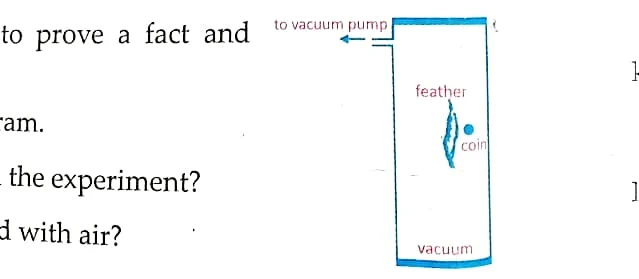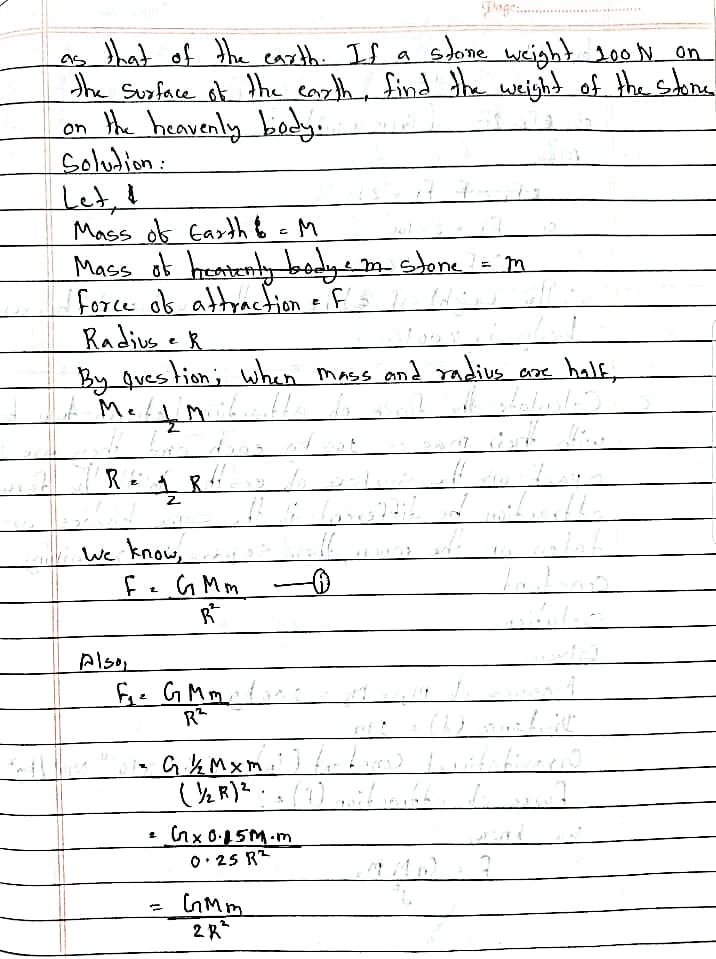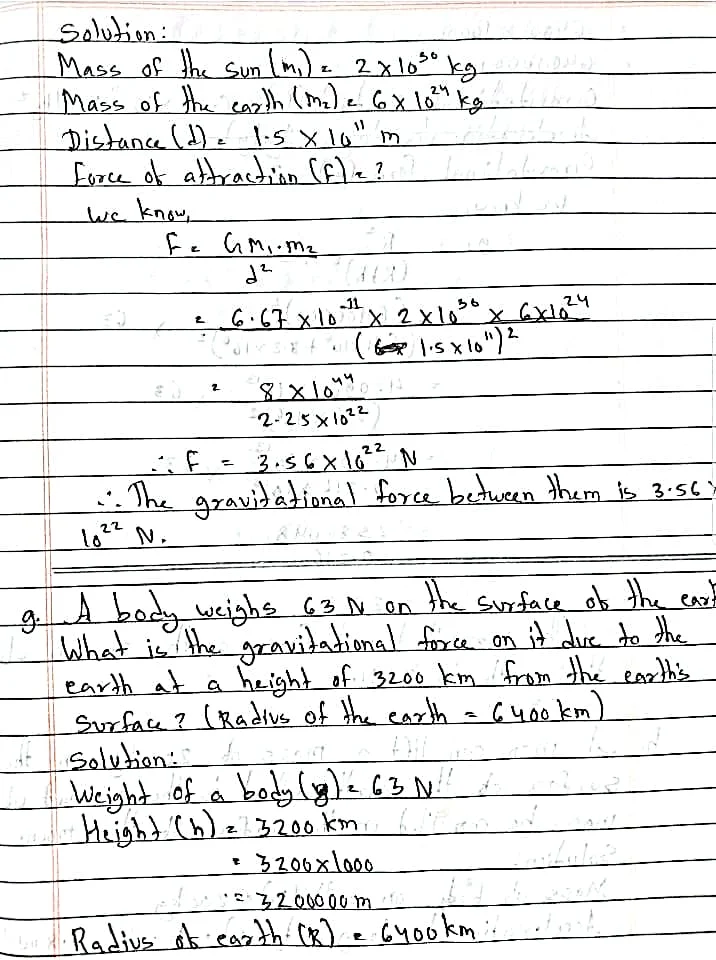Force: Class 10 Science Notes
Force Class 10 Science Complete Notes. This note include all the excercise given in force chapter of science book such as question answer, numericals, give reason, diagrammatic questions and define the following. This note is published for helping students to solve their problems.
If you find any mistakes or feel like giving any suggestions then feel free to comment down.
Related Searches 🔍
- Force class 10 Notes
- Force chapter class 10 pdf
- Class 10 Science notes Nepal PDF
- Class 10 Science Force chapter
- Class 10 Science chapter 1 Force
- Grade 10 Science Notes PDF
- Khullakitab class 10 Science notes
- Class 10 Force important questions
- Give reason of Science class 10
- Khullakitab class 10 Science Force
Chapter - 1
Force
📚EXERCISES
2. Answer the following questions:
a. What is gravitation? What are the factors that affect gravitation? Write the SI unit of gravitation.
- Mass of the body
- Distance between their centre
The SI unit of gravitation is Newton.
b. State Newton's Universal Law of gravitation.
Ans: Universal law of gravitation states that "everybody in this universe attracts another body with a force, which is directly proportional to the product of their masses and inversely proportional to the Square of the distance between their centres.
c. What will happen to the gravitational force between two bodies if the distance between them is halved keeping their masses constant?
Ans: We know, gravitational force is given by;
F = (Gm₁.m₂)/d² ---------------- ( i )
According to the statement, distance between two bodies is halved i.e. d₂ = (½d)²
Now,
F = (Gm₁.m₂)/d²
or, F = {4(Gm₁.m₂)/d² ---------------- ( ii )
From equation ( i ) and ( ii )
∴ F = 4F [ F = (Gm₁.m₂)/d² ]
Thus, the gravitational force will be four time greater than before is if the distance between them is halved keeping the mass constant.
d. What will be the gravitational force between two heavenly bodies if the masses of both are keeping the distance between two constant?
Ans: We know, gravitational force beyween two bodies is given by;
F = (Gm₁.m₂)/d² ---------------- ( i )
According to statement, mass of both body is tripled i.e m₁ = 3m₁ , m₂= 3m₂
Then,
F = (G.3m₁.m₂)/d²
or, F = 9 {(Gm₁.m₂)/d²} ---------------- ( ii )
From equation ( i ) and ( ii )
∴ F = 9F
Hence, the gravitational force will get increased by 9 times it both masses are tripled keeping distance constant.
e. What will be the gravitational force between two bodies if the masses of each is doubled and the distance between is halved?
Ans: We know, the gravitational force between two d bodies is given by ;
F = (Gm₁.m₂)/d² ---------------- ( i )
According to the statement, the mass of both bodies is doubled and distance between them is halved. ie. m₁ = 2m₁ , m₂= 2m₂ and d² = (d/2)²
Then,
F = (G.2m₁.2m₂)/d²
or, F = {(G2m₁.2m₂)/d²} × 4
or, F = 16 (Gm₁.m₂)/d² ---------------- ( ii )
From equation ( i ) and ( ii )
∴ F = 16F
Hence, the gravitation force will be 16 times greater if mass of both object is doubled and distance between them is halved.
f. Define G. Also write its value and SI unit.
Ans: G is defined as gravitational force produced between two bodies of unit mass each when they are kept at a unit distance from their centre.
It's value is 6.67 × 10-¹¹ Nm²/kg² and its SI unit is Nm²/kg².
g. In this formula, g = GM/R², what do G,M and R stands for ? Prove that g ∝ 1/R².
Ans: In this formula, g = GM/R² , G,M and R stands for gravitational constant, mass of the body and radius respectively.
Prove that g ∝ 1/R²
Solution :
Let 'm' be the mass of the object and 'R' be radius.
According to Newtons law of gravitation,
F = (GM.m)/R² ---------------- ( i )
Also,
The force with which the body is attracted by the earth towards its centre is given by;
F = mg ---------------- ( ii )
Now from ( i ) and ( ii )
mg = GMm/R²
or, g = GM/R² ---------------- ( iii )
Since, G and M are constant but R is variable then equation (iii) becomes;
g ∝ 1/R² ---------------- ( iv )
h. What will be the effect on the acceleration due to gravity of the earth if it is compressed to a size of the moon?
Ans: If the size of the earth is compressed to a size of moon then the acceleration due to gravity of the earth increases as the radius of the earth will be less after it gets compressed.
i. The acceleration due to gravity of Jupiter is 25 m/s². What does it mean?
Ans: The acceleration due to gravity of Jupiter is 25m/s² means that if any object is dropped near Jupiter Surface, it will accelerate downward at the rate 25 m/s² due to gravity of Jupiter.
j. A Coin and a feather dropped in Vaccum. Which one will reach the ground first? Why?
Ans: If a coin and a feather are dropped in vaccum then both of them will reach the ground at same time because in vaccum there is no air resistance for hindering the falling object.
k. Where does a body have more weight at the pole or at the equator of the earth? Explain with reason.
Ans: A body has more weight at poles than at equator of the earth because the polar radius is less than equatorial radius due to which force of attraction will be more and because of that weight will be more.
l. When an apple falls towards the earth, the earth moves up to meet the apple. Is this true? If yes, why is the earth's motion not noticeable?
Ans: When an apple falls towards the earth, the earth moves up to meet the apple. Yes, it is true but the earth's motion is not noticeable because of less magnitude of force.
n. An astronaut is said to be weightless when he travels in a satellite. Does it mean that the hearth does not attract him?
Ans: An astronaut is said to be weightless when he travels in a satellite but it does not mean that the earth does not attract him. The earth's gravity has less effort on him due to less effort of the earth and negligible gravity in space, the astronaut feel weightless.
o. What is the importance of gravitational force? Write any two points.
- We are able to perform our daily activities due to the existence of gravitational force
- The existence of atmosphere around the earth is possible due to gravitational force.
p. What is freefall? What happens to the weight of a body when it is falling freely under the action of gravity?
Ans: When a body is falling freely towards the centre of the earth under the influence of the gravitation pull of the earth, the motion of the body is called free fall. When a body is falling freely under the the action of gravity, the acceleration of the body will be equal to the acceleration due to gravity due to which weight seems to be zero.
q. What is the effect of gravity on a falling object? Write the conclusion obtained from the coin and feather experiment.
Ans: When an object is falling on surface of the earth, the gravity helps them to accelerate. In this condition, the earth's gravity acts like a magnet and attract the falling object.
The feather and coin experiment proves that, in an vaccum any object fall at the same rate independent of their respective masses.
r. Write the differences between the fall of a Parachute on the earth and its fall on the moon? On what condition does a body have free fall?
Ans: The earth has 6 times higher gravitational force than moon due to which the parachute will fall on moon taking six times more time than that on earth.
If the acceleration of body is equal to the a I value of acceleration due to gravity of that place then at this condition the body have free fall.
s. Write any two examples of weightlessness.
- A person in a lift which is falling or in a state of freefall
- People in satellites
t. Define:
i. Acceleration due to gravity
Ans: The rate of change of velocity due to gravity is called acceleration due to gravity.
ii. Weightlessness
Ans: Weightlessness is the state of the body in which it feels that the body is not influenced by any force.
iii. Freefall
Ans: When the body falls freely under the influence of gravity with no external resistance, then the fall is known as free fall.
iv. Null point
Ans: The space between any two heavenly bodies at which the resultant gravity is zero, is called the null paint.
3. Distinguish between:
a. Gravity and gravitation
| Gravity | Gravitation |
|---|---|
| It is a force of attraction of the earth on a body. | It is the mutual force of attraction between two bodies. |
| It is a strong force. | It is a weak force. |
| Eg: Earth pulls an object of 1kg towards it with a force of 9.8N |
Force of attraction between any two object such as books, table, chair and between two heavenly bodies. |
b. Gravity and acceleration due to gravity
| Gravity | Acceleration due to Gravity |
|---|---|
| It is a force of attraction of the earth on a body. | It is acceleration produced on body due to gravity. |
| It is the cause of acceleration due to gravity. | It is the effect of gravity. |
| It's SI unit is Newton. | It's SI unit is m/s². |
c. Mass and Weight
| Mass | Weight |
|---|---|
| It is the amount of matter contained in a body. |
It is the force with which a body is attracted towards the centre of earth. |
| Its value is the same everywhere in the universe. | Its value differ from place to place. |
| It is a scalar quantity. | It is a vector quantity. |
d. g and G
| g | G |
|---|---|
| It is the acceleration produced on a body. | It is the gravitational force between two unit masses separated by a unit distance from their centre. |
| Its unit is m/s². | Its unit is Nm²/Kg². |
| It is a vector. | It is a scalar quantity. |
e. Free fall and Weightlessness
| Freefall | Weightlessness |
|---|---|
| If a body is falling freely under the action of gravity without any external resistance then it is called freefall. | Weightlessness is the state of a body in which it feel that the body is not influenced by any force. |
| Eg: fruit falling from tree. | Eg: Person standing in a lift falling downward. |
f. Gravitational force and acceleration due to gravity.
| Gravitational Force | Acceleration due to gravity |
|---|---|
| The force of attraction between any two object by virtue of their masses is called gravitational force. | It is a acceleration produced on a body due to gravity. |
| Its SI unit is Newton (N). | Its SI unit is m/s². |
g. Weightlessness in space and weightlessness on the earth
| Weightlessness in Space | Weightlessness on Earth |
|---|---|
| If the body shows its apparent weight zero in space then it is weightlessness in space. | If a body shows its apparent weight zero in earth then it is weightlessness on earth. |
| Weightless in space is seen at null point. | Weightlessness on earth is seen when the body is in free fall state. |
4. Give reason:
Ans: Newton's law of gravitation is called a universal law because this law holds truth for all the bodies whether it is microscopic or massive placed everywhere in the universe.
b. The weight of a body decreases with increase in distance from the earth's surface.
Ans: The weight of a body decreases with increase in distance from the earth's surface because when the distance increases from earth surface the value of 'g' decreases due to which weight of a body also decreases.
c. The weight of a stone is less at the top of a mountain than that at its bottom.
Ans: The weight of a stone is less at the top of a mountain than that at its bottom because the value of 'g' is more at bottom than at top due to less distance from sea level.
d. The weight of a body is less at the moon that its weight on the earth.
Ans: The weight of a body is less at the moon than its weight on the earth because the weight of a body depends upon the gravity and the gravitational force is less on moon than on the earth.
e. The moon has no atmosphere.
Ans: The moon has no atmosphere because the value of gravitational force is so less on the surface of the moon due to which it cannot attract the molecules of gases.
f. The value of g is greater at the poles than at the equator.
Ans: The value of g is greater at the poles then at the equator because the value of g is inversely proportional to the distance between the object and centre of the earth and we know that equatorial radius is greater than polar radius.
g. There is more role of the moon than the sun to cause tides in oceans.
Ans: There is more role of the moon than the sun to cause tides in oceans because the tides are caused by the gravitational force of both moon and the sun but the moon is closer to the earth than sun So, it has higher gravitational force to cause tides.
h. Tides occur in oceans but not in lakes.
Ans: Tides occur in oceans but not in lakes because the mass of water of lake is less than the mass of water of ocean due to which the gravity of the moon is not much active there.
i. It is difficult to lift a large stone on the surface of the earth but it is easy to lift small one.
Ans: It is difficult to lift a large stone on the surface of the earth but it is easy to lift small one because we know that the mass of large stone is more than the mass of small stone due to which the force of attraction of the earth is more on large in stone than that on small one.
j. Mass of the Jupiter is 319 times more than that of the earth but its acceleration due to gravity is only 2.5 times more than the earth.
Ans: Mass of the Jupiter is 319 times more than that of the earth but its acceleration due to gravity is only 2.5 times more than the earth because the radius of jupiter is nearly 11 times larger than earth and we know that acceleration due to gravity is inversely proportional to the square of radius of an object.
k. The weight of a body will be zero during free fall.
Ans: The weight of a body will be zero during free fall because in this condition the acceleration of a body will be equal to the value of 'g' due to gravity.
l. A paratrooper does not get injured while jumping on the earth surface from a flying aeroplane.
Ans: A paratrooper does not get injured while jumping on the earth from a flying acroplane because the parachute that he is wearing helps to slow down the acceleration by filling it with air.
m. When a coin and a feather are dropped from the roof of a building, the coins reaches the ground earlier.
Ans: When a coin and a feather are dropped from the roof of a building, the coin reaches the ground earlier because the mass of coin is greater than the feather due to which the earth attract the coin with greater force than the feather.
5. Diagrammatic questions.
1. The earth revolves around the sun in its orbit as shown in the figure. Is there any difference in the amount of gravitational force of the sun towards the earth when the earth moves from point A to point B on its orbit? Explain.
Ans: The force of gravitation of the sun towards the earth increases as the earth moves from point A to point B because the radius is less at B than A and we know that value of 'g' is inversely proportional to the square of radius.
2. Study the diagram of an experiment to prove a fact and answer the following questions:
a. Name the experiment given below.
Ans: The name of experiment is "feather and coin" experiment.
b. What conclusion can be drawn from the experiment?
Ans: From this experiment, we knew that in a vaccum the acceleration due to gravity of a freely falling body will be same irrespective to their masses.
c. What effect is seen it the tube is filled with air?
Ans: If the tube is filled with air then the coin will fall at first than the feather as coin has more mass than feather.
3. Study the given diagram and find the gravitational force between two spherical object.

Solution:
Mass of first body (m₁) = 800 kg
Mass of second body (m₂) = 400 kg
Radius (d) = 8m
Gravitational Constant (G) = 6.67×10-¹¹Nm²/kg
We know,
F = (Gm₁.m₂)/d²
= (6.67×10-¹¹×800×400)/8²
= 3.335×10-⁷ N
If Class 10 Force Notes were helpful to you then feel free to share this notes with your friends & classmates.






















thanks
☺
Chapter 5 6 7 9 10 11..... 23
Science chapter 5 6 6 9 10 11...... 23
Thanks